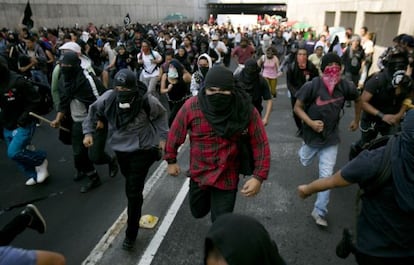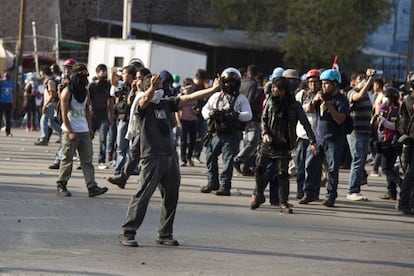Hooded anarchists: the new Mexican riddle
The actions of various masked individuals at social-issues demonstrations raises doubts about their identities and interests

There were about 200 of them and they were at the back of the march that yesterday marked the 45th anniversary of the Tlatelolco massacre. They represented 10 percent of those present. Some had covered their faces. Someone began to call them "anarchists" and some of them identified themselves as such. Most of them are not more than 20 years old. Some looted a 24-hour store. Others threw molotov cocktails at the police. In the wake of the clashes that left 83 injured and led to 100 arrests, these individuals have been called "instigators" and "violent types," but nobody can clear up their identities or motives. Yet, their outburst was nothing new. The city had prepared. What happened yesterday was the chronicle of a riot foretold.
"There are strange images. A group of youths looting an Oxxo [a 24-hour store] is an act of provocation. But I don't think they represent the majority of those marching," explained an analyst. The NGO Artículo 19 documented 22 attacks on journalists. Only two were committed by the alleged anarchists. Fourteen were perpetrated by the police and the rest have not yet identified their aggressors. Another video released yesterday shows a police officer beating a group of seemingly unarmed young people with a helmet. Some of the officers were dressed in civil clothes. They used rubber bullets to disperse the crowd.
The city's government had prepared for the march. The side streets in the historic city center - where some were planning on ending the march -- were reinforced with 1,700 police officers. Although violent clashes at protests have become more frequent since President Enrique Peña Nieto took office, the outburst of the masked youths was not a new phenomenon. Authorities have attributed six attacks with homemade bombs against ATMs in Mexico City between 2009 and 2010 to some hooded individuals.
The investigators say the masked youths share some of the characteristics of the Black Bloc collective, a movement from Germany that recently appeared in demonstrations in Brazil, and with the Anarchist Student Group that led some of the riots during the agrarian strike last month in Colombia. "Yes, the modus operandi is the same," said Jorge Enrique Rocha Quintero, coordinator of the masters program in Politics and Public Management at the Instituto Tecnológico de Estudios Superiores de Occidente. "There are radical groups that go beyond protesting against the government. They are in another league. They demand autonomy and self-management."
Their precursors are the 1990s movements against globalization. "We have to remember that since these protests began to take place during the international summits, the organizers have said that the clashes were caused by infiltrators who came in to create chaos, and, above all, to feed this image of the social protest as violent," Rocha Quintero said.
On the internet making a parcel bomb looks easy. There are instructions for Molotov cocktails, homemade anti-gas masks and even ski masks made with t-shirts. "Once they identify you, you or a member of your group, the persecution will be imminent, which why you should be alert and wear a hood when the situation calls for it,"one manualexplains. "If you show your face or another identifiable part of your body at an 'illegal' action you will surely be found out at the next 'legal' action that you decide to attend." Another image says "if there is repression at the march then wearing a hood is not a crime."

Investigators say that inequality and the ever worsening economic crisis feed the wrath of the people. "We have to acknowledge that we face a systemic crisis, even though the governments talk about a supposed renewal of capitalism," Rocha Quintero said. "It is getting more and more obvious that there is growing disparity, not just in Mexico, where there is great social inequality, but also in the rest of the world. There are people who are left out of any kind of growth."
"It's one of the consequences that led to the 2011 youth rebellions around the world," added Carlos Aguirre Rojas, researcher at the Institute for Social Research at the Universidad Nacional Autónoma de México and author of about 20 books on the topic. "It's clear that there are more and more young people, with a developed political conscience, who are excluded, who cannot find employment congruent with their level of education."
Some youths who identify themselves as anarchists explain how to recognize the more radical elements. A poster describes the members of the self-proclaimed anarchist group, Bloque Negro. "It's easy to recognize them because they come equipped for the clashes." Other demonstrators call the hooded elements porros - a term used to denote government-paid infiltrators who spread chaos. In a protest on December 1, 2012 members of the movement #YoSoy132 or IAm132 described "heavily armed individuals in civil clothes standing behind the barricades."
Rocha Quintero said the violence "monopolizes the media and leaves little room to discuss the demands of these social movements." Just yesterday some youths were talking about the riots on an anarchist forum online. "Let the attacks focus solely on the government and its employees. Stop causing damage to cars and everything else," one of them wrote. Another said, "Because of them they almost beat us up. How could they put people's lives in danger? If I wanted to knock out the riot police then I would do it and stand responsible for the consequences, but you cowards hide in the crowd. You are not the real representatives of anarchism."
Translation: Dyane Jean François
Tu suscripción se está usando en otro dispositivo
¿Quieres añadir otro usuario a tu suscripción?
Si continúas leyendo en este dispositivo, no se podrá leer en el otro.
FlechaTu suscripción se está usando en otro dispositivo y solo puedes acceder a EL PAÍS desde un dispositivo a la vez.
Si quieres compartir tu cuenta, cambia tu suscripción a la modalidad Premium, así podrás añadir otro usuario. Cada uno accederá con su propia cuenta de email, lo que os permitirá personalizar vuestra experiencia en EL PAÍS.
¿Tienes una suscripción de empresa? Accede aquí para contratar más cuentas.
En el caso de no saber quién está usando tu cuenta, te recomendamos cambiar tu contraseña aquí.
Si decides continuar compartiendo tu cuenta, este mensaje se mostrará en tu dispositivo y en el de la otra persona que está usando tu cuenta de forma indefinida, afectando a tu experiencia de lectura. Puedes consultar aquí los términos y condiciones de la suscripción digital.
Últimas noticias
Trump clarifies who is ultimately in charge in Venezuela: ‘Me’
Maduro pleads not guilty before the federal court in New York: ‘I am still the president of Venezuela’
A new test can detect Alzheimer’s from a finger prick
UN team enters Sudanese city of El Fasher after paramilitary massacre: ‘It’s like a ghost town’
Most viewed
- Gilles Lipovetsky: ‘If you want to live better and fall in love, take Prozac, don’t look to philosophy’
- Alain Aspect, Nobel laureate in physics: ‘Einstein was so smart that he would have had to recognize quantum entanglement’
- Alvin Hellerstein, a 92-year-old judge appointed by Bill Clinton, to preside over Maduro’s trial in New York
- Why oil has been at the center of Venezuela-US conflicts for decades
- Cuba confirms death of 32 of its citizens in the US attack against Venezuela








































